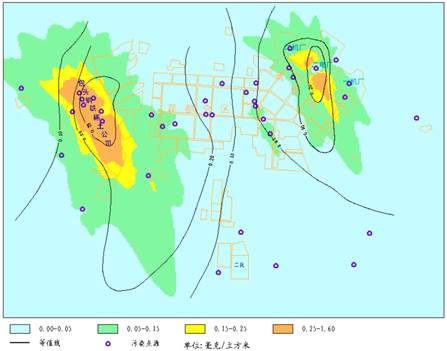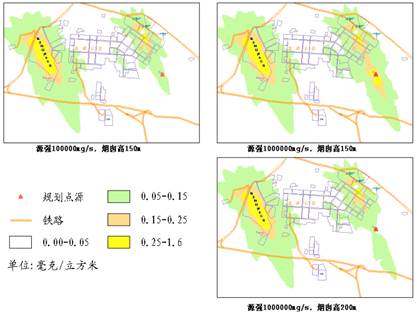With the development of economy, environmental pollution has a direct impact on people’s quality of life, and environmental quality has also been paid more and more attention. Pollution environment includes water pollution, air pollution, solid waste pollution and so on. As far as air pollution is concerned, urban area has become a concentrated area of air pollution due to the influence of industrial production and residents’lives. Several serious pollution accidents in history, such as London Smoke Event (1952) and Los Angeles Photochemical Smoke Event (1943), all occurred in big cities. In recent decades, researchers have done a lot of research on atmospheric pollution, and established the diffusion model of atmospheric pollutants suitable for specific regions and the calculation method for determining the relevant parameters through experiments or calculations.
Urban air pollution sources mainly include point pollution sources and linear pollution sources, the former mainly includes chimneys, the latter refers to automobile exhaust emissions. Besides emissions, the diffusion of pollution is also affected by meteorological conditions, underlying surface and other factors. Through the study of atmospheric dynamics, various analytical equations describing the diffusion of pollutants in the atmosphere are given. These atmospheric diffusion formulas provide a certain basis for air pollution prediction, and provide practical and effective information for reducing harmful pollutant emissions under unfavorable meteorological conditions, regional planning and environmental impact assessment in urban planning.
Whether point source pollution or line source pollution, its spatial distribution and attributes can be managed by GIS, and the spatial distribution of the impact factors of pollution diffusion can also be used as part of the spatial data of GIS. Therefore, the diffusion model of air pollution can be established based on GIS. Furthermore, GIS provides abundant functions to show the spatial distribution of pollutant intensity. It can query the distribution of intensity and make more detailed evaluation and analysis combined with other social and economic data.
The application of GIS in the simulation of air pollution diffusion in Baotou City of Inner Mongolia Autonomous Region is introduced below.
Baotou is the largest rare earth industrial base in China and one of the famous industrial base of steel machinery. It is a complete range, the system is more perfect modern industrial city. Baotou Industrial energy consumption is mainly coal-fired, accounting for 56%, followed by Coke and electricity, in the energy structure, heavy pollution of energy accounted for 70.8%, Baotou industrial emissions of SO2, smoke dust and fluoride are larger, resulting in Baotou soot type and fluorine pollution characteristics. 21 of these key air pollution sources account for the city’s industrial emissions of 95%,85%,96% (SO2, smoke dust and fluoride, respectively). Baotou Steel is the largest pollution manufacturers, its SO2, dust, fluoride emissions are the highest.
From the natural conditions, Baotou is located in the interior, and the climate is inland semi-arid, medium temperate continental monsoon, throughout the year is dry, frost-free is short. The average annual temperature is 6.5 ℃ and the heating period is 6 months. Due to the impact of the terrain, the north and northwestern wind is more in winter in Baotou, the southeastern winds is more in summer, the popular NWW wind is in each month night. In recent years, the urban architecture and natural vegetation have rapidly been developing, the area of artificial greening has been expanding, the average wind speed in urban areas shows a year-on decline trend. The average annual wind speed in 1995 was 2.2m/s. In a year, the spring wind speed is the largest, autumn wind speed is the smallest, winter wind speed is centered. Except in July, where the dominant wind direction is the opposite of the maximum wind speed, the prevailing wind direction coincides with the maximum wind speed and direction.
The inversion layer affects the diffusion and dilution of pollutants. The frequency of inversion is high in winter and low in summer. The intensity and thickness of inversion in winter are obviously larger than that in summer.
Baotou is a key city for air pollution control in China. There are many studies on air pollution diffusion in Baotou. In 1982, the General Institute of Architectural Research of the Ministry of Metallurgy put forward the Atmospheric Transport Climatology Model (ATCM) by means of wind tunnel simulation test and field experiment, aiming at the comprehensive control plan of flue gas in Baotou Iron and Steel Company. In 1989, according to the atmospheric diffusion model and SO2 capacity calculation in Baotou New Urban Area, Baotou Environmental Monitoring Station proposed an ISC (Industrial Compound Source Atmospheric Diffusion Model) model based on EPA in the United States. The establishment of these models provides a reliable basis for the control and management of air pollution in Baotou City.
The model of air pollution diffusion is established by using GIS
To simulate the spatial distribution of pollutants and evaluate the environmental quality of different regions;
The spatial distribution of pollutants and population density were analyzed to determine the number of population affected by pollution;
Predict the spatial distribution of pollutants under given meteorological conditions;
Determine the contribution of different point sources to the total amount of pollution in the whole study area
Provide decision-making basis for pollution remediation, such as reducing emissions or even closing some pollution sources;
If we want to increase the pollution point source, we can compare different schemes (such as the location and height of the chimney) and choose the best one;
In urban planning, it is used to determine the distribution of different land uses (residential, industrial, commercial, etc.).
In the research work of Baotou City, the spatial variation of SO2 concentration caused by 37 elevated point sources in Baotou City is simulated by using the average wind speed, wind direction and frequency in January and converted into wind frequency meter. The results are shown in Fig. 14-4. Fig. 215 Distribution of atmospheric sulfur dioxide in Baotou City # 
The forecasting results of the model are compared with the contour maps drawn by Baotou Environmental Monitoring Station. The predicted value of the model is more realistic in the industrial area. In Kundulun area, the predicted value is relatively small. The reason is that the industrial pollution in Baotou area has less impact on the area under the specific wind direction in January. In contrast, the sulfur dioxide pollution caused by heating and burning coal by residents is more prominent. Generally speaking, no matter from industrial or residential areas, the concentration of SO2 predicted by the model does not differ in order of magnitude.
In the atmospheric environmental planning, it is necessary to predict the pollution caused by the new sources, to select the reasonable location of the new sources, to determine the discharge volume of the new sources and the height of the point source chimney. In the study, a new pollution source is proposed to be added to the Youth Farm (triangle point on the map). There are three schemes: the one is that source strength is 100,000 mg/s, the height of the chimney is 150 meters. The other is that the source strength is 1000,000 mg/s, the height of the chimney is 150 meters. The third is that the source strength is 1000,000 mg/s, and the height of the chimney is 200 meters. The results are superimposed on the original pollution distribution. The results are shown in Fig. 14-5. Fig. 216 Distribution of Pollution by Increasing Pollution Sources with Different Parameters # 
The victim population of air pollution is the most important object of concern in the management and control of air pollution. Based on the population distribution of Baotou New Urban District (Qingshan District and Kundulun District), the changes of the victim population of SO2 pollution in the atmosphere before and after adding new sources were analyzed. The research method is to superimpose the predicted results of the model with the administrative divisional map containing population data, and obtain the area and population of each polluted area. The results are shown in Table 14-1.
Table 14-1: Results of Population Change Caused by Adding New Pollution Sources (Unit: Ten Thousands)
Unit of concentration: mg/m3 | 0.00-0.05 | 0.05-0.15 | 0.15-0.25 | 0.25-1.6 |
The strength of new source: 100000 mg/s The height of new source: 150 meters | 46.05 | 15.33 | 2.10 | 0.80 |
The strength of new source: 1000000mg/s The height of new source: 150 meters | 36.20 | 24.30 | 2.73 | 1.04 |
The strength of new source: 1000000mg/s The height of new source: 200 meters | 41.02 | 20.02 | 2.33 | 0.89 |
Atmospheric conditions before addition | 49.83 | 15.61 | 2.03 | 0.80 |
From the charts and tables, it can be seen that the number of high-concentration victims caused by pollution sources with a source strength of 1000,000 mg/s has increased significantly, while the number of high-concentration victims caused by new pollution sources with a source strength of 1000,000 mg/s has changed little. At the same time, it can be seen that increasing the height of pollution sources to reduce the harm of pollution is at the cost of increasing the number of low-concentration victims. From the analysis of the pollution of newly added pollution point sources, we can consider the establishment of a new point source with a source strength of 100,000 mg/s and a chimney height of 150 meters at the location of the youth farm.